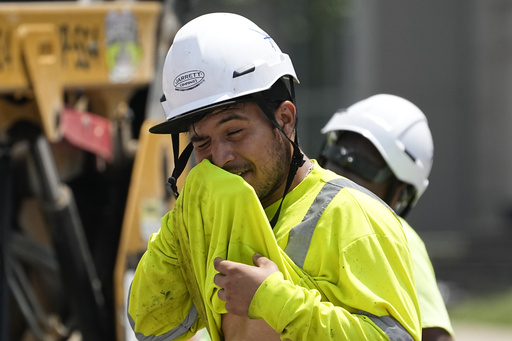On a scorching summer day in Oak Ridge, Tennessee, a group of workers diligently cleared out pipes, asbestos, and other hazardous materials to decontaminate a nuclear facility in preparation for its demolition. Engulfed in protective coveralls and equipped with respirators, these workers braved the sweltering conditions inside a powerless building. To monitor their well-being in the extreme heat, workers wore armbands that tracked their vital signs including heart rates, movements, and exertion levels for signs of heat stress. Stephanie Miller, a safety and health manager overseeing the cleanup efforts at Oak Ridge National Laboratory, closely monitored a computer screen displaying real-time physiological data of the workers to ensure their safety amidst the high-risk environment.
In response to the rising global temperatures, employers are increasingly turning to wearable technologies to safeguard workers. These innovative devices gather biometric data to estimate core body temperature, a key indicator of heat-related illnesses, and remind workers to take breaks to cool down. Originally designed for athletes, firefighters, and military personnel, these wearables are gaining traction as heat-induced productivity losses are projected to cost the U.S. around $100 billion per year. Despite the benefits of these technologies, concerns exist regarding the protection of sensitive medical information collected from employees. Labor groups fear that employers might misuse this data to penalize workers for taking necessary breaks, highlighting the importance of establishing proper safeguards and privacy guidelines around the use of wearable devices.
While workers at the Tennessee cleanup site utilize heat stress monitors manufactured by SlateSafety, there is a lack of federal regulations in the U.S. to protect most workers from extreme heat exposure. The Biden administration recently proposed a rule to safeguard 36 million workers from heat-related illnesses, emphasizing the need for comprehensive workplace safety guidelines. Wearable technologies like the SlateSafety armbands are revolutionizing heat stress management in diverse work environments, ranging from hazardous waste cleanup sites to industrial facilities.
These high-tech armbands are also being utilized beyond the cleanup sites. Companies like Perrigo and Cardinal Glass have implemented wearable devices to monitor employees’ core body temperature and mitigate heat stress risks. With the potential to predict core body temperature accurately, these wearables offer a proactive approach to ensuring worker safety in challenging environments. Despite advancements in wearables, concerns persist about the reliability of these devices in dynamic workplaces, with factors like age, gender, and ambient humidity affecting temperature readings.
The implementation of wearable devices has already shown promising results in improving worker safety. Xavier Allison, a laborer at the Oak Ridge site, shared his experience of receiving alerts from his device during a heatwave, prompting him to take necessary cool-down breaks. By effectively managing heat stress, the number of workers requiring medical attention has significantly decreased, underscoring the potential of wearable technologies in enhancing workplace safety.
As companies collect and analyze sensitive health data from employees through these wearables, questions arise regarding data privacy and potential misuse by employers. To address these concerns, experts recommend strict data processing protocols, allowing workers to opt-in or out of wearing monitoring devices, and deleting unnecessary information promptly. While wearable technologies offer a partial solution to combat heat stress, a comprehensive approach that includes access to breaks, shade, and hydration remains crucial to ensuring the well-being of workers in hot environments.


